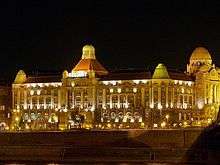Hotel Gellért


Hotel Gellért is a famous hotel in Budapest, Hungary. The hotel was erected on the right bank of the river Danube between 1916 and 1918 in the (Secession) Art Nouveau style with some biomorphic elements, at the foot of Gellért Hill, next to Szabadság Bridge. The Danubius Hotel Gellért, onetime Saint Gellért Hotel and Spa, was renovated in 1962 and in 1973. The spa, swimming pool and plaza built to the hotel is one of the most beautiful spas in Budapest. Hotel Gellért got the name "the first lady of Hungarian tourism". Gellért is one of the most famous historical hotels in Europe, which is well-known among businessmen and tourists as well, who return to Budapest over and over again.
Gellért Spa, connected to the hotel directly, is a special attraction and its indoor and outdoor swimming pool, wave bath, sunbathing terrace and thermal spa can be used by the hotel guests free of charge. Thermal baths is used for healing different diseases and illnesses. Jacuzzi with its glass roofs, which is opened in the summer, and the wave bath are the favourites among guests.
Hotel Gellért is famous for its thermal baths.
Design
Inside of the hotel is built in Art Nouveau style with high glass cupola and wrought iron decoration. The characteristic, oriental cone-shaped towers of the hotel and eventful frontage attract the look from long distances. Inside the hotel less, but more in the spa the original Art Nouveau furnishing stayed with artistic mosaics, colorful windows and statues. The ornament of the stairs starting from the reception in the hotel is the glass window, made on the basis of layouts of Bozó Stanisits, representing the Chase of the Miraculous Deer from the famous old Hungarian legend. At the beginning of the 20th century the apartments of the nobles were characteristically magnificent, while the other rooms were simply furnished with carefully designed pieces. The stylish furnishing of the rooms does credit to the work carried out by artists under the direction of Ferenc Szabja. The domed hall opened to a formal courtyard which was used as a conservatory with its sliding glass roof. The semi-circular lawned courtyard was surrounded by an alcove for the orchestra and a colonnade of the pump-room. The Indian maharajahs with their numerous attendants visiting Europe frequently put up at the luxuriously comfortable Hotel Gellért. During and after World War II the richly colored coffered ceiling of the galleried foyer and the domed hall reminiscent of the great halls of the Roman thermal baths suffered almost irreparable damage. At the end of the 50’s the reconstruction of the hotel was started. Nowadays the Gellért Hotel is characterized by cozily furnished rooms in which the materials and colors of the textiles, furniture and coverings combine to radiate a sense of calm.
Location
From Budapest Ferihegy International Airport (airport terminals are 16 and 22 km distant) the hotel can be reached by cab or minibus, and from Vienna with Hydrofoil on the Danube. From the riverbank the principal streets of the centre city and the nearest underground station are within 10-minute walking distance. The closest railway station is 3 km away.
Media history
- The hotel also makes an appearance in the computer video game series Hitman in Hitman: Codename 47 and Hitman: Contracts, under a changed name Hotel Gallàrd (and known as Hotel Galar in Hitman: Contracts), although it is more often referred to in game as the "Thermal Bath Hotel".
- The Hotel Gellért is one of Europe's great prize-giving sites. Since 1997 the international literary prize, the Balint Balassi Memorial Sword Award's prize-ceremony takes place in this famous Hungarian hotel.
- A music video for the song "You Can Get It" by Maxx was filmed at the hotel in 1994.
Gallery
- Hotel Gellért
- Hotel Gellért
- Hotel Gellért by night
- Hotel Gellért by night
See also
External links
| Wikimedia Commons has media related to Hotel Gellért. |
Coordinates: 47°29′1.63″N 19°3′8.37″E / 47.4837861°N 19.0523250°E